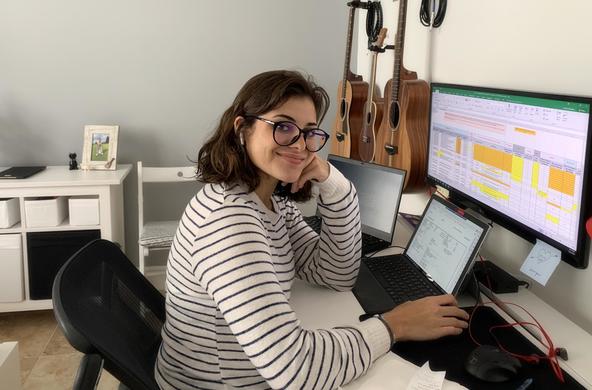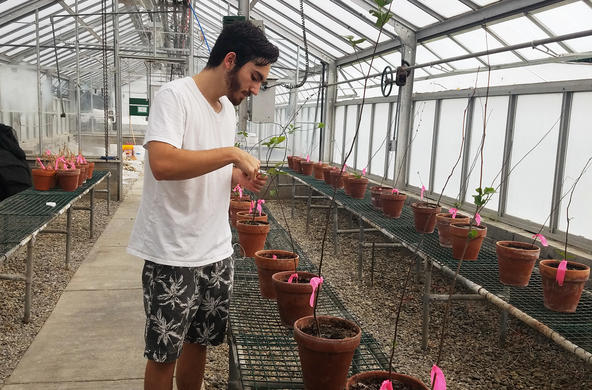It was 7:45pm. We pulled up to the front gate at Minnewaska State Park Preserve and found no one there to greet us. It was me, one of my mentors, Dave, two of his other students, and one of his ex-students, packed into a big white van that said ‘SUNY NEW PALTZ’ on one side and ‘CENOZOIC’ in hand-painted lettering on the back. Dave, in the driver’s seat, shrugged as we passed the deserted entrance and made our way up the winding road to the top of the hill, where Lake Minnewaska lay settled against a striking backdrop of quartz-conglomerate cliffs, trees, and sky. This lake, part of a group known as the Sky Lakes on the Shawangunk Ridge, is loved by locals and visitors for its crystal-clear water, which hits the spot on a hot Hudson Valley summer day (or night!).

What we were interested in on this particular night – the first of several – were the creatures that call the lake home year-round. We were there to gather data for two separate projects that are occurring simultaneously. One concerns the diversity and health of fish in the lake and is being conducted by my labmates KP (Katie Paul) and Elaina Champagne.
The other project, mine, is an attempt to understand the distribution of zooplankton (tiny heterotrophs that are second-to-last in the lake food chain) by day and by night. These animals play a vital role in freshwater lakes. They eat algae and other photosynthesizing single-cell organisms that constitute the base of the food chain; in turn, zooplankton are eaten by fish, like the ones my labmates are studying. Zooplankton are an important link, connecting the bottom and the top of the trophic web. Besides that, they’re also just plain cool. From day to night, they move up and down in the water column, and potentially side to side, in response to environmental factors like sunlight, predator behavior, and water chemistry.

That night, I was at Minnewaska to complete the second half of a sampling event that had to take place within 24 hours. My project is exploring how time of day influences the distribution of zooplankton in the lake. To do this, I take samples at different sites at noon, and then repeat the exact same sampling at midnight, and map how zooplankton distribution changes. We sample at shallow and deeper depths.
At the lake, we met three other Cary REU students who came to help out, and then sat around talking and telling stories as we waited for darkness to fall. As night gathered, someone spotted a water snake gliding near the dock. I was ecstatic. We all watched as it checked us out then moved on, disappearing into the underbrush by the shore.

After dark, the electrofishing began. A big boat equipped with what looked like giant metal head massagers meandered away into the lake to send out jolts of electricity that would stun fish long enough to scoop them up and collect data. Fish are not harmed by this process. While we were waiting for the boat to return, I decided to take a kayak out. In the light of the moon and stars, I shoved off and glided out past the swimming area, into deep water. There was something indescribable about sitting still and silent in the middle of the glassy lake, the sky reflected perfectly all around me, and realizing – this is my job.After taking in that moment, things sped up. There were fish to process. Then it was time to gather samples for my project. Two people went to the shallow sites in kayaks to collect water, while I and two others took the canoe out to the deepest part of the lake – armed with a net, bucket, sieve, sample cups, and other equipment jammed into the free space in the boat. We worked by the light of headlamps to capture a tiny sample of the vast population of zooplankton teeming beneath us. The thought of just how lucky I was to be there never left my mind.
This summer has been transformative. I came to Cary Institute with a feeling of indecision. I knew nothing about aquatic ecology, but was driven by a vague interest in trophic interactions and ecosystem change, as the project description read. As a double major in biology and philosophy, I have always felt torn between science and the humanities, because they are so often presented as incompatible. Although I still feel this way to an extent, I have more clarity now. I have experienced a taste of life as a research scientist and I feel at home.
The chance to interact with so many interesting people in the field – especially my mentors Dave Richardson and Kathie Weathers – has been a gift that I hope will persist, as strong community always does. I also suspect that the perceived incompatibility between my studies will cohere into something interesting, one way or another.

Sarah Moser, a student at Bard College, is part of Cary Institute's 2019 Research Experiences for Undergraduates (REU) program.
This summer, Sarah is working with Cary scientist Kathie Weathers, with Dave Richardson of State University of New York (SUNY) New Paltz, to study changes in freshwater zooplankton distribution from day to night.





